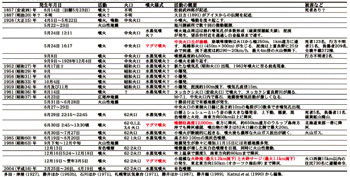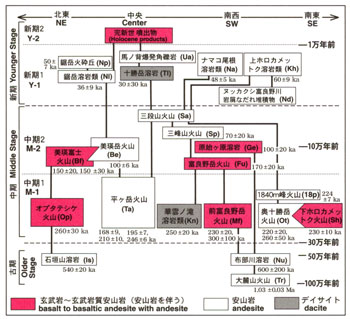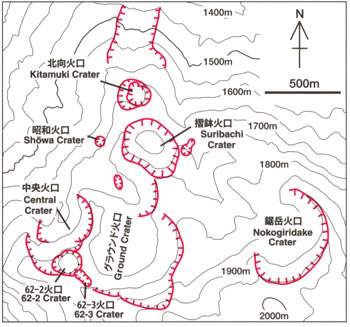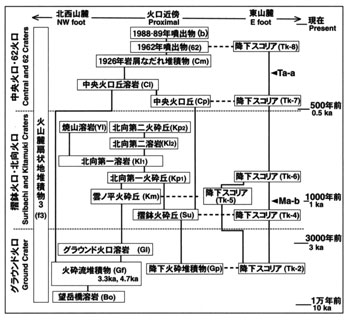Tokachidake Volcano
1: Introduction / 2: Overview of the Tokachidake Volcano Group
3: Eruptive history of the Tokachidake Volcano Group
4: Eruptions in historical times
5: Petrological features of erupted rocks - 6: Sulfur deposit and hot springs
7: Observation of volcanic activities - 8: Points to be noted for mitigation of volcanic disaster
Acknowledgements / References
![]() PREV
PREV ![]() NEXT
NEXT
3: Eruptive history of the Tokachidake Volcano Group
The eruptive history of the Tokachidake Volcano Group was previously divided into three stages, the Older, Middle, and Younger, based on the morphology of each volcano and its petrographic features of erupted rocks ( Katsui et al., 1963a ). In this geologic map, we re-define the three stages on the basis of their new radiometric ages along with the distribution of eruption centers and petrological features of erupted rocks. The Older, Middle and Younger stages were active from 1 Ma to 500 ka, from 300 to 60-50 ka, and after 60-50 ka, respectively ( ![]() Fig. 1 ).
Fig. 1 ).
3.1 Older stage
The products of the Older stage consist of andesitic Tairokusan Volcano ( Tr ), Nunobegawa Lava ( Nu ), and Ishigakiyama Lava ( Is ). Tairokusan Volcano is only distributed in the southern part of the map and has the gentle slope of a volcanic edifice with less volcanic topography. Its eruptive center is estimated to the outside ( south ) of this map based on the distribution of deposits. The Nunobegawa Lava and Ishigakiyama Lava are narrowly exposed along the Nunobegawa River and on the ridges of the volcano group, respectively. Their eruptive centers are not known.
3.2 Middle stage
The Middle stage is characterized by the expansion of the distribution for eruptive centers. The products consist mainly of basaltic to andesitic lava and pyroclastic deposits forming stratovolcanoes with a minor amount of dacite lava. Radiometric ages obtained from the products suggest that there seems to be a hiatus of inactivity up to several hundreds of thousand years between the Older and Middle stages. The Middle stage is subdivided into the M-1 stage ( 300 to 200 ka ) and M-2 stage ( 200 to 60-50 ka ) in terms of their radiometric ages and the distribution of eruptive centers.
In the M-1 stage, basaltic Oputateshike Volcano ( Op ), Maefuranodake Volcano ( Mf ), and Shimohorokamettoku Volcano ( Sh ) were active in the northeast, southwest, and southeast parts of the Tokachidake Volcano Group, respectively. Oputateshike Volcano is accompanied with andesite. Andesitic Tairagatake Volcano ( Ta ), Okutokachidake Volcano ( Ot ), and 1840m-peak Volcano ( 18p ) were also active in the central part of the volcano group. Dacitic Kaunnotaki Lava ( Kn ) is only distributed in the upstream of the Nukkakushi-Furano River. Most volcanoes of this stage have obscured craters due to advanced erosion.
In the M-2 stage, basaltic Bieifuji Volcano ( Bf ) and Furanodake Volcano ( Fu ) together with andesitic Bieidake Volcano ( Be ), Sanpozan Volcano ( Sp ), and Sandan'yama Volcano ( Sa ) were active. These volcanoes were built in the space between volcanoes active during the M-1 stage. Therefore the volcanoes of the M-2 stage are elongated to NW-SE direction perpendicular to the major trend of the volcanic chain. Basaltic Genshigahara Lava ( Ge ) is distributed in the southern foot of Furanodake Volcano and is mostly covered by volcanic fan deposit-1. Its eruption site is not known, however, it is attributed to one of the products from lateral craters belonging to Furanodake Volcano based on the distribution, radiometric age and petrological features of rocks. Horseshoe-shaped craters open to the west in the summits of Bieidake and Furanodake volcanoes. Craters of other volcanoes in this stage are obscured due to later burial or erosion.
Volcanic fan deposits-1 is widely distributed in the foot of the volcanoes in the Middle stage.
3.3 Younger stage
The products attributed to the Younger stage are those active later than 60 to 50 ka. Eruptive centers converge to the central part of the Tokachidake Volcano Group. The length of the hiatus between the Middle stage and the Younger stage is not clear. The rocks belonging to this stage consist of basalt to andesite lava and pyroclastics erupted from multiple craters. Based on the difference of eruptive centers and ages, this stage is further subdivided into two: the Y-1 and Y-2 stages. Lava topography is clearly visible in the Younger stage.
3.3.1 Y-1 stage
During the Y-1 stage, eruptions occurred within 3 km in diameter around Kamihorokamettoku Yama, Nokogiri Dake and the summit of Tokachi Dake in the central part of the Tokachidake Volcano Group. Nukkakushifuranogawa Debris Avalanche Deposits ( Nd ) flowed down from the area near Kamihorokamettoku Yama were followed by andesitic Kamihorokamettoku Lavas ( Kh ), Namakoone Lavas ( Na ), and Umanose Explosion Breccia ( Ua ). The crater around Kamihorokamettoku Yama is largely lost by collapses and erosions that enlarged original shape. Around Nokogiri Dake, andesitic Nokogiridake Lava ( Nl ) flowed down and Nokogiridake Pyroclastic Cone ( Np ) that consists mainly of andesitic blocks with cooling joints along with lapilli to ash matrix with sag structures was formed. The summit of Tokachi Dake consists of dacitic Tokachidake Lava ( Tl ) with relative height of about 100 m. Volcanic fan deposits-2 is distributed in the upstream of Y-1 stage deposits.
3.3.2 Y-2 stage
Activities belonging to the Y-2 stage include those of the Ground, Suribachi, Kitamuki Central and 62 craters on the northwestern side of the summit of Tokachi Dake ( ![]() Fig. 2 ), and the Nukkakushi crater ( Ansei crater ) on the western side of Kami-Horokamettoku Yama. Those eruptive activities occurred in Holocene. At the Nukkakushi crater ( Ansei crater ) the activity was only phreatic eruption, while in other craters the eruptions were accompanied with magma eruptions. Ejecta of the Y-2 stage consist of lava flows, pyroclastic fall deposits, and pyroclastic flow deposits accompanied with a small amount of debris avalanche deposits. They are mostly basaltic andesite with lesser amount of basalt and andesite. In the Y-2 stage, explosive eruptions and lava extrusion have repeatedly occurred. Those deposits are covered by volcanic fan deposits-3.
Fig. 2 ), and the Nukkakushi crater ( Ansei crater ) on the western side of Kami-Horokamettoku Yama. Those eruptive activities occurred in Holocene. At the Nukkakushi crater ( Ansei crater ) the activity was only phreatic eruption, while in other craters the eruptions were accompanied with magma eruptions. Ejecta of the Y-2 stage consist of lava flows, pyroclastic fall deposits, and pyroclastic flow deposits accompanied with a small amount of debris avalanche deposits. They are mostly basaltic andesite with lesser amount of basalt and andesite. In the Y-2 stage, explosive eruptions and lava extrusion have repeatedly occurred. Those deposits are covered by volcanic fan deposits-3.
The ejecta before 4.7 ka in the Y-2 stage have been subdivided based on 1 ) difference of source craters, 2 ) petrological features of essential ejecta, and 3 ) existence of hiatuses over several hundred years( Fujiwara et al., 2007, 2009).In this geologic map, this subdivision is revised adding a lava flow that flowed down in early Holocene. Stratigraphic relation of the ejecta is shown in ![]() Fig.3.
Fig.3.
It is note that the crater in the western Kamihorokamettoku Yama has been previously called the Nukkakushi, Older or Ansei craters. In this map the name the Nukkakushi crater ( Ansei crater ) is used.
Ejecta from the Ground crater
The Ground crater consists of more than two smaller craters opening in the northwestern direction. Its diameter is approximately 800 m. Judged from the distribution of lava flows that extruded from the Ground crater, it seems that another crater existed to the north of currently visible small craters.
The lowermost deposit derived from the Ground crater is Bogakubashi Lava ( Bo ). This lava is an andesite block lava over 20 m thick distributed from 1,130 to 700 m above sea level. From the radiometric carbon dating of charcoals below the lava, it is no doubt that the activity was during early Holocene. The eruptive source cannot be identified as the lava is widely covered by later ejecta. However, it is reasonable that the source is the Ground crater based on the distribution of the lava.
Ground Crater Pyroclastic Flow Deposits ( Gf ) at 4.7 ka and 3.3 ka are distributed at the between 1,570 and 620 m above sea level, and reached the Shirogane Hot Spring. Their thicknesses are less than 10 m. Those two pyroclastic flows are shown combined on this geologic map because the distribution of the pyroclastic flow deposits of 4.7 ka is narrow. The pyroclastic flow deposits of 4.7 ka consist of scoria with little pumice as essential ejecta with many accessory and accidental materials as lithic fragments. The pyroclastic flow deposits of 3.3 ka are subdivided into upper and lower deposits. Essential components of ejecta of the upper unit are scoria and pumice while the lower is scoria. The lower unit contains many accessory and accidental lithic fragments in addition to essential ejecta. There is no evidence suggesting hiatus between upper and lower units. Among these essential ejecta, scoria is basaltic andesite and pumice is andesite. Judging from the lithofacies and the shape of the Ground crater, it seems that both 4.7 ka and 3.3 ka pyroclastic flow deposits were accompanied with collapse of the volcano.
Ground Crater Pyroclastic Fall Deposits ( Gp ) derived from the Ground crater was erupted 3.3 ka and is widely distributed around the crater. The essential ejecta are scoria and pumice. Distal facies of this pyroclastic fall deposits ( Tk-2 ) is distributed in the ESE direction of the crater reaching near Obihiro City 70 km away.
Ground Crater Lava ( Gl ) extruded near the end of activity of the Ground crater is distributed in the northwestern of the crater between 1,400 and 960 m above sea level, and near the Shirogane Hot Spring at 730 to 670 m above sea level. The rock is basaltic andesite and rarely contains vesiculated pumice fragments.
Total volume of ejecta from the Ground crater deposits is estimated to be 0.07 km3 DRE ( dense-rock equivalent ).
Ejecta of the Suribachi and Kitamuki craters, and Yakeyama Lava
The Suribachi and Kitamuki craters, and Yakeyama lava, all of which are situated in the north of the Ground crater, are aligned in the direction of NNW-ESE and were active at about the same time. The ejecta are all basaltic andesite.
The Suribachi crater with the diameter of 400 m is a crater of symmetrical inverted cone shape occurring within the Suribachi Pyroclastic Cone ( Su ). The ejecta are mainly of welded pyroclastics accompanied with pyroclastic surge deposits. On the crater wall is exposed Tairagatake Lavas of the Middle stage. Therefore the Suribachi crater is a maar. Scoria fall deposits ( Tk-4 ) derived from the Suribachi crater is distributed in the ESE of the crater. It is overlain by Ma-b tephra ( about 1,000 yBP ) derived from Mashu Volcano, eastern Hokkaido, suggesting that the age of the Suribachi crater must be older than 1,000 yBP.
The Kitamuki crater consists of closely spaced multiple small craters that repeated formation of pyroclatic cones and extrusion of lavas. The sequence of eruptive events and mutual covering relationships are shown in ![]() Fig.3.
Fig.3.
The Kumonotaira Pyroclastic Cone ( Km ) has a crater opened to the north and forms a pyroclastic cone with somewhat elongated shape parallel to this direction. The base is pyroclastic surge deposits. Small distribution of scoria fall deposits ( Tk-5 ) is seen in the east. Kitamuki-1 Pyroclastic Cone ( Kp1 ) is a small cone about 500 m in diameter. Scoria fall deposits ( Tk-6 ) is distributed to ESE direction and overlies Ma-b tephra ( about 1,000 yBP ). Kitamuki-1 Lava ( Kl1 ) fills a crater situated in the center of Kumonotaira Pyroclastic Cone and reaches 3.5 km down along the Abare River. Kitamuki-2 Lava ( Kl2 ) is small lava flowed down about 600 m from the crater to the west. Kitamuki-2 Pyroclastic Cone ( Kp2 ) is very small pyroclastic cone of 200 m in diameter.
Yakeyama Lava ( Yl ) is distributed at the foot between 1,000 and 780 m above sea level. Vegetation on the surface is poorer than that of Kitamuki-1 Lava. Crater is not clearly recognized. Judging from the distribution, it is inferred that the source existed at around 1,000 m above sea level in height, which is the lowest eruptive source for Holocene activities.
The total volume erupted ejecta is estimated to be 0.037 km3 DRE.
Ejecta of the Central crater
Materials ejected from the Central crater are Central Cone ( Cp ) and Central Cone Lava ( Cl ). Central Cone is situated in the northwestern side of the Ground crater and forms a pyroclastic cone of 50 m in relative height. During the 1926 eruption, a part of the cone has collapsed to form opening in NW direction, but before that time the shape was a pyroclatic cone slightly elongated in NE-SW direction. A small-scale scoria fall deposits ( Tk-7 ) correlated to the Central crater cone is distributed in ESE of the Central crater. The ejecta are basalt. Central Cone Lava is an Aa lava spreading along an erosional valley on Tairagatake Volcano from the Central crater down to 910 m above sea level for about 2 km. This lava is about 5 m thick and directly covers a scoria fall deposits ( Tk-7 ) ejected from the Central crater. The rocks are basaltic andesite. Total volume of ejecta from the Central crater is estimated to be 0.019 km3 DRE.
Ejecta of the Nukkakushi crater ( Ansei crater )
Ejecta of the Nukkakushi crater ( Ansei crater ) are deposits of multiple phreatic eruptions in Holocene. Major constituents of the deposits are altered lithic fragments distributed in a small area around the crater. The latest of the ejecta covers Ta-a tephra ( AD 1739 ) derived from Tarumae Volcano, southwestern Hokkaido. It is not shown on this map because its distribution is quite limited.



